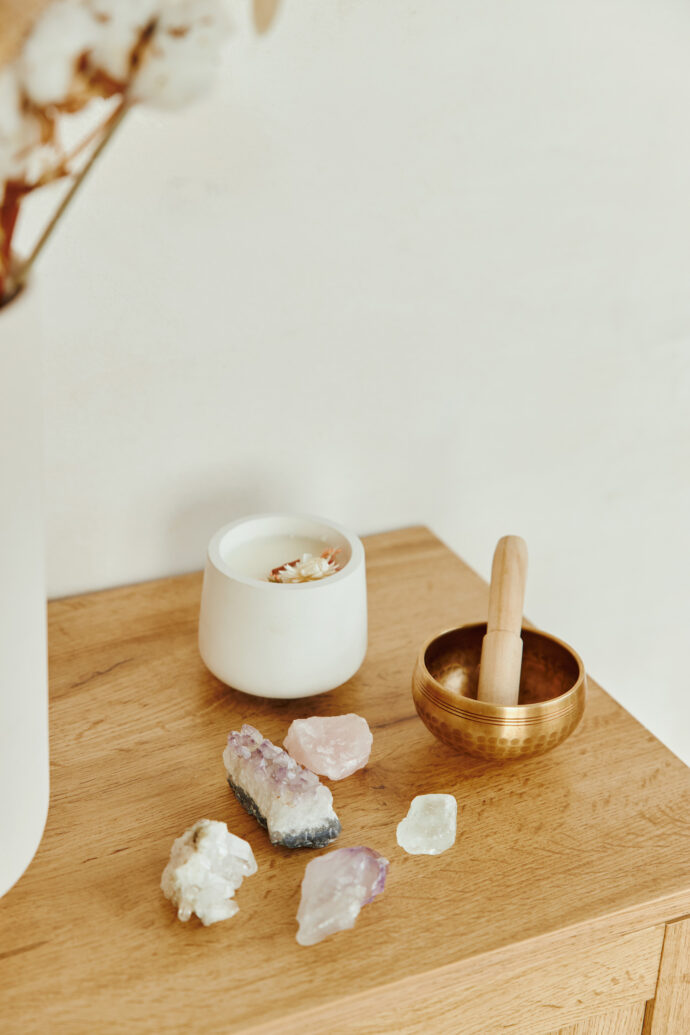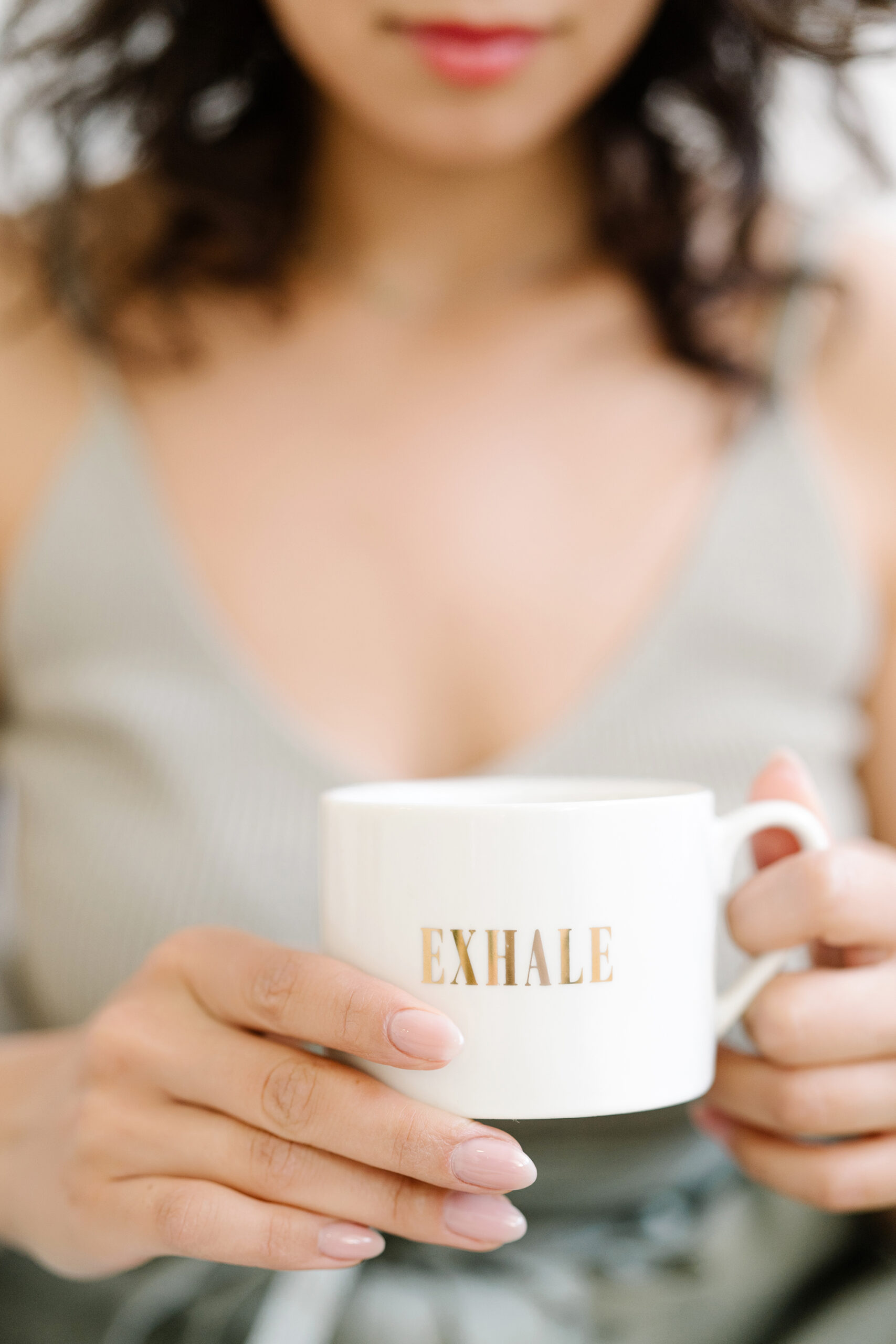Let’s talk about deep breathing exercises and how this very simple, yet completely underrated act can hold the power to nurture our souls and enhance our mental well-being all at the same time!
I know that sounds like some pretty big shoes to fill, but trust me, practicing deep breathing exercises on a regular basis can have life changing results.
In the fast-paced world we live in, finding moments to pause, breathe, and reconnect with our inner selves is so important for maintaining a sense of balance and inner peace within us.
Adding these techniques into your daily routine will help to open the door to so many amazing benefits that extend beyond just relaxation.
Think stress and anxiety reduction, lower blood pressure and heart rate, balance oxygen and carbon dioxide in the blood. I could go on!
It’s seriously so amazing what deep breathing exercises can do for you. It goes way beyond just helping to calm yourself (although that’s another incredible benefit too!)
With a focus on mindfulness and intentional breathing, we can begin to pave the way to a deeper connection with our inner selves and the world around us.
Today, I want to spend a little time talking about deep breathing exercises and the transformative impact this can have on our daily lives.
So let’s get to it!

Understanding the Power of Breath
Breathing is a remarkable tool that can transform our emotional state and overall well-being.
It’s something we do without putting much, or any, thought into it. But if we begin to lean more into the art of conscious breathing, we can unlock incredible benefits that extend far beyond just the physical.
So let’s get more into the profound impact of deep breathing exercises on our minds and emotions.
Benefits of Deep Breathing
Deep breathing opens up a world of advantages for our body and mind.
Deep breathing increases the flow of oxygen throughout your body, revitalizing cells and enhancing overall cognitive function.
This surge of oxygen also helps to improve focus and concentration, allowing us to tackle tasks with clarity and precision.
Through the activation of the relaxation response, deep breathing soothes the nervous system, reducing stress levels and promoting a sense of overall calmness.

Connection Between Breath and Emotions
Our breath is intricately intertwined with our emotions. It acts as a bridge between our inner selves and the external world around us.
Slow, full breaths signal a since of comfort and safety.
But on the other hand, think about a time when you were really scared or felt uneasy. Your breathing probably wasn’t deep and relaxed. It was most likely it was quick and shallow.
Our breath patterns have a way of signaling to our brain what kind of emotional state we’re in. Rapid, shallow breaths are often related to feelings of anxiety and tension.
But we can regulate our breathing patterns through intentional deep breathing.
With this technique we can effectively manage our emotions and cultivate a sense of balance and tranquility.
Through the simple act of conscious breathing, we can begin a journey of self-discovery and inner peace. The incredible connection between breath and emotions helps to cultivate a harmonious and balanced existence both in and around us.
Types of Breathing Techniques
Breathing techniques are powerful tools that can help calm the mind, reduce stress, and promote inner harmony.
Here are some different types of deep breathing exercises that you can practice on a daily basis to enhance calmness and your spiritual well-being.
Diaphragmatic Breathing
Diaphragmatic breathing, aka deep belly breathing, focuses on engaging the diaphragm to promote relaxation.
By breathing deeply into the belly, you can reduce stress levels, improve oxygen flow, and enhance mindfulness. This technique can also help improve posture, increase oxygen supply to the bloodstream, and activate the body’s relaxation response.
Box Breathing
Another great breathing technique is the box breathing method. It’s a simple yet effective technique that involves a four-step process of inhaling for a count of four, holding for a count of four, exhaling for a count of four, and holding the breath again, for, you guessed it, a count of four.
This method is a wonderful way to help calm the mind and bring you back to the here and now. I love this technique for moments when I feel unusually stressed or tense. You begin to focus on yourself on an inner level and the outside stressors slowly start to disappear.
Alternate Nostril Breathing
This one is my personal favorite.
Alternate nostril breathing is a yogic breathing practice that involves breathing through one nostril at a time. This technique aims to balance the energy channels in the body. Finding balance between the masculine and feminine energy and creating a sense of inner harmony.
By alternating the flow of breath between the left and right nostrils, you can enhance focus and reduce anxiety all at the same time.
To begin, you’ll start by using your right hand-place your pointer finger and middle finger on your third eye. Place your thumb along your right nostril and your ring finger on your left nostril. Take a deep breath in through both nostrils, hold your breath for just a second. Now cover your right nostril with your thumb and breathe out through your left nostril. Take a deep breath in, hold, now cover your left nostril and breathe out through the right.
Continue to do this as many times as you need until you begin to feel yourself coming back into alignment.
Practice these breathing techniques on a regular basis to experience their full benefits and begin to enhance your spiritual and emotional well-being.

Incorporating Relaxation Practices
Incorporating relaxation practices into your daily routine can significantly enhance your overall well-being and bring a sense of calm to your soul.
By combining deep breathing exercises and relaxation methods together, you begin to nurture both your mind and body.
Mindfulness Meditation
Mindfulness meditation is an amazing practice that allows you to focus fully on the present moment.
You’ll begin by sitting in a quiet, calm space. Use one of the breathing techniques mentioned above to begin to focus fully on yourself and let go of any distractions around you.
Continue to focus on your breath. Then start to notice any sensations within your body. Do you feel tense or discomfort at all? Notice the feeling of your body sitting in the chair. Your feet on the floor. Just notice the feelings, but don’t act on them. This is all about just paying attention and being present.
Then you can begin to bring more attention to your thoughts. Don’t attach any emotion to them. Just notice them and let them pass on.
Practicing mindfulness meditation regularly will help to deepen your connection with yourself and help to promote a sense of peace from within. It’s a very grounding practice and one I love to do either first thing in the morning or early evening when I’m starting to wind down for the night.
Progressive Muscle Relaxation
Progressive Muscle Relaxation (PMR) is a technique that involves tensing and then relaxing each muscle group in your body.
I love doing this in bed right before falling asleep. It’s so relaxing and I always find myself drifting off to sleep so much faster.
This practice helps release physical tension and promotes relaxation for both the body and the mind which is why it’s so perfect to do right before going to sleep.
If you’ve had a particularly trying day and your thoughts are racing, PMR can be a great way to let the stress of the day go so you can fall asleep peacefully.
Incorporating mindfulness meditation and progressive muscle relaxation into your daily routine is powerful way to reduce stress and enhance your own self-awareness.

Creating a Relaxation Routine
Deep breathing exercises are essential for nurturing the soul and laying the foundation for a healthier you.
To fully benefit from these practices, it’s crucial to establish a relaxation routine that can be seamlessly integrated into your daily life.
Here are some super simple tips to help you create a routine that harmonizes your mind, body, and soul:
Setting Up a Calming Environment
Creating a soothing environment is key to maximizing the effectiveness of your relaxation routine. Keep a few things in mind when creating your calming space:
• Declutter: A cluttered space will make you feel anxious and overwhelmed. Start by decluttering your surroundings. This will also help you limit distractions, making it easier for you to focus on the breath.
• Soft Lighting: Opt for soft, warm lighting that creates a serene ambiance. My favorites are candles or salt lamps. They create that perfect glow that always give me all the spa vibes.
• Comfortable Seating: No peace or comfort will be found while sitting on a stiff, wood chair. Instead make sure you have something comfortable to sit on. A comfy chair or cozy cushion is perfect to help get you relaxed and settled in. The last thing you want to focus on is a sore bottom.
• Natural Elements: Incorporate elements of nature such as plants or natural scents like lavender to help bring you into the present moment and let those worries fade away.

Establishing a Consistent Practice
Consistency is key when it comes to reaping the full benefits of a relaxation routine. Here are some helpful tips to help you stay committed to your practice:
• Set Realistic Goals: Start with achievable goals to prevent overwhelm and to help keep you motivated.
• Schedule Regular Sessions: Set aside some specific times in your day (preferably the same time each day) for relaxation practices to ensure you prioritize your well-being.
• Track Your Progress: Keep a journal to track your progress and reflect on how your relaxation routine is positively impacting you.
• Accountability Partner: Consider involving a friend or family member to help you stay accountable and motivated.
By implementing these strategies and staying dedicated to your relaxation routine, you can experience profound benefits for your mind, body, and soul, leading to a more balanced and harmonious life.
We’ll End things Here
Deep breathing exercises are powerful tools for nurturing the soul and achieving a sense of inner peace.
The wonderful thing about these exercises is they don’t have to take very long. Setting aside just a few minutes a day to give your mind and body a rest will have profound impacts on your mental and physical health.
Remember to start slow, breathe deeply and you will find a more balanced self.
A calmer, more centered you is only a breath away.



Transform Your Nights. Evening Routines for a Better Tomorrow - An Hour of Secrets
[…] out to help relax your mind and body. I have a whole post dedicated to this topic. You can find it here if you’re interested in learning […]
Slow Living Made Simple: How to Start Living Intentionally - An Hour of Secrets
[…] gentle mornings, more space to breathe, embracing the little simplicities of life with open arms. Taking every moment and dipping it in […]
A Year of Mindful Living: Monthly Intentions to Simplify and Slow Down - An Hour of Secrets
[…] the air gets cooler and the days grow shorter, September gives us space to take a step back, breathe deeply, and recharge. It’s a time to embrace quieter moments, like curling up under a soft blanket with […]